Cutting wood, need the right tool, don’t want to sound silly? A full comparison of the hatchet vs. axe, differences and similarities, when you should use them, and recommendations on what to buy.
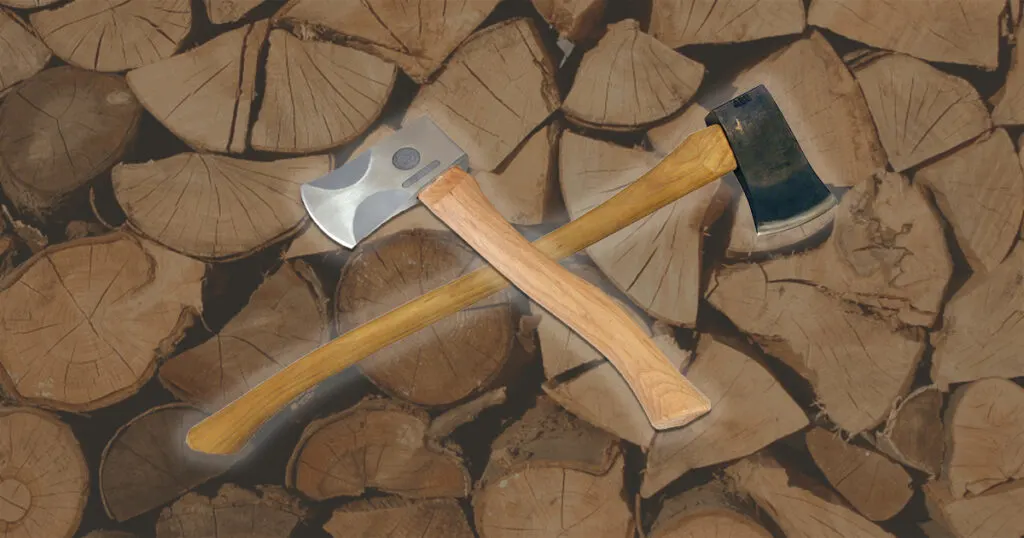
- What’s the difference between an axe and a hatchet?
- When should I use an axe vs hatchet?
- What are the similarities?
- The history of the axe.
- Anatomy of an Axe
- Anatomy of a Hatchet
- My Axe Recommendations
- My Hatchet Recommendations
What’s different between an axe and a hatchet?
An axe is double the length of a hatchet. And you’re going to notice the head shape between hatchets and axes vary. The head of a hatchet is also smaller and has a significant taper. The head of an axe is larger and has a very slight taper (if any at all).
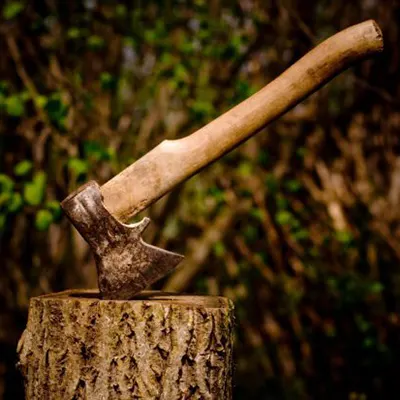
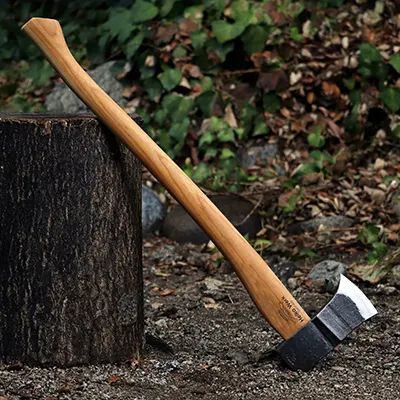
A hatchet can effectively be used with one hand, typically meant for chopping smaller pieces of firewood or small branches.
An axe is large enough for use with two hands (for maximum striking power). Axes are used for chopping larger wood.
When should I use an Axe vs. Hatchet?
When to use an Axe
- Splitting firewood
- Cutting down a tree
- Hewing lumber
What is hewing lumber?
Hewing is a centuries-old process of converting a round log into square lumber for use as building material.
When to use a Hatchet
- Split small pieces of firewood
- Cut down saplings & very small trees
- Chop small branches off a tree or bush
- Useful when camping
What are the similarities of an axe and a hatchet?
An axe and a hatchet look very similar (other than the size difference) and it’s not hard to confuse the two.
With both an axe and a hatchet, the purpose is typically to cut wood. The difference between the two is in the scale and ability of each.
Both the axe and the hatchet have a steel head with a sharp edge called a bit. Both also have a handle that can be made out of either wood or a strong composite material.
What’s the history of the axe?
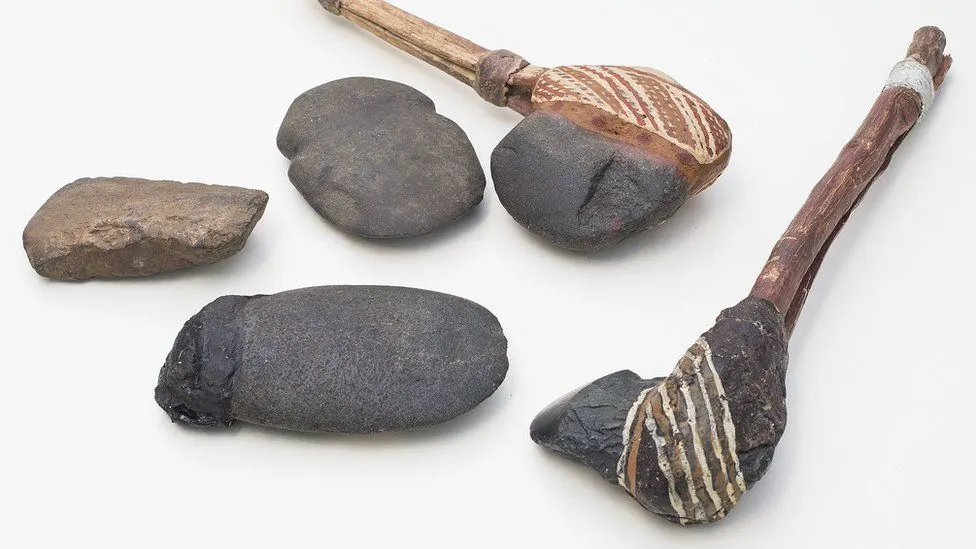
Archaeologists have deduced that they were usually attached to a handle to form a tool much like a hatchet. Such implements are often associated with the development of agriculture but ancient examples from Australia vastly pre-date agriculture anywhere in the world…
BBC News
The axe is thought to be one of the oldest tools ever used by man. Meaning: it probably dates back before we can actually… date back. We think that the earliest known axes were known as “hand axes”.
The hand axe head was “pear-shaped” and made with chipped stone to create a point, it most likely had a broad handle. We assume early man used the hand axe to butcher animals or dig up roots.
Parts of an Axe
Think of this as the anatomy of the axe. Each and every section of an axe has a name, these are the parts of an axe.
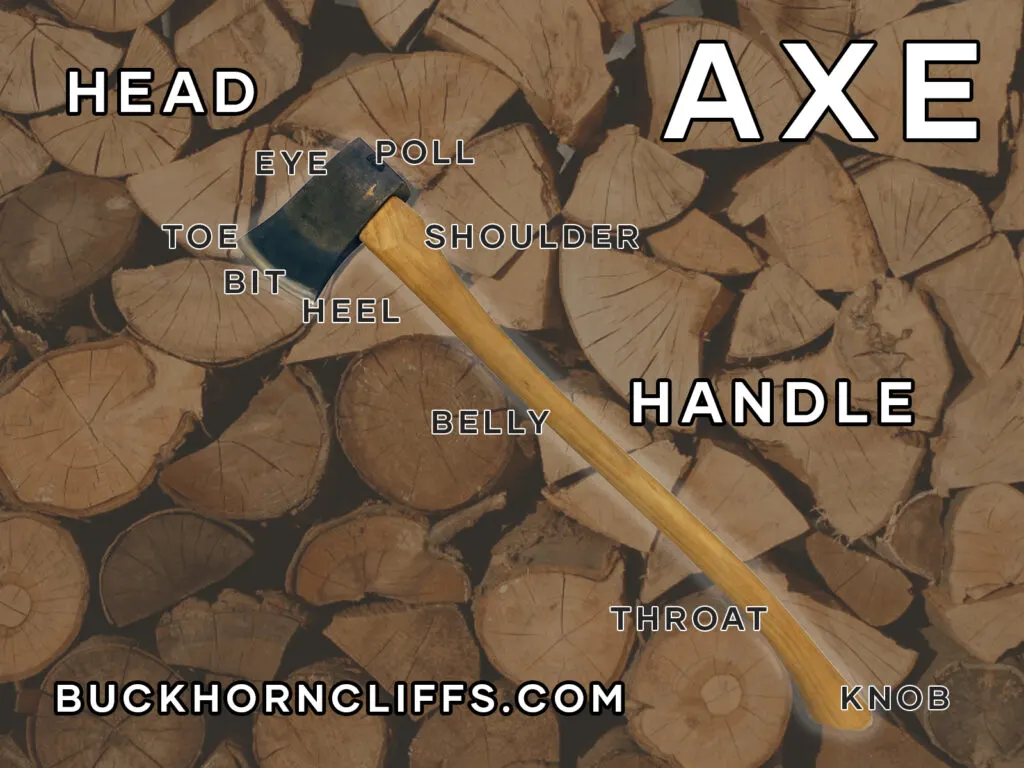
Head of an Axe
The head of an axe is the part of the tool that is used for cutting or chopping. It is typically made of metal and is attached to the handle, or haft, of the axe. The head typically consists of a blade and a poll, with the blade being the sharp, cutting edge and the poll being the opposite end of the head that is used for striking or pounding. The shape and size of the head can vary depending on the type of axe and its intended use. For example, a felling axe may have a longer and wider head with a more pronounced blade, while a hatchet may have a smaller and more compact head with a shorter blade.
Eye
The eye of an axe is the hole at the end of the handle, or haft, that the head of the axe is attached to. It is called the “eye” because it is typically shaped like an eye, with a round or oval opening at the end of the handle. The head of the axe is inserted into the eye and secured in place with a wedge, which helps to keep the head from coming loose during use.
The size and shape of the eye can vary depending on the type of axe and the size of the head. In general, the eye should be slightly larger than the head of the axe to allow for easy insertion and secure attachment. The head of the axe should also be properly aligned with the handle to ensure that it is balanced and easy to use.
In addition to serving as the point of attachment for the head of the axe, the eye can also provide a grip point for the user when swinging the axe. The handle of the axe should be long enough to allow the user to hold it with both hands, with the eye being located near the end of the handle where it can be easily gripped.
Toe
The toe of an axe refers to the very tip of the blade on the cutting edge of the head. It is the part of the axe that makes contact with the material being cut or chopped, and it is often the thinnest and most pointed part of the blade. The shape and size of the toe can vary depending on the type of axe and its intended use. For example, an axe used for felling trees may have a wider and more blunt toe, while an axe used for carving or splitting wood may have a thinner and more pointed toe.
The toe is an important part of the axe because it determines the overall cutting performance of the tool. A sharp and well-maintained toe will make it easier to cut through wood or other materials, while a dull or damaged toe will make the axe less effective and may require more effort to use. It is important to keep the toe of the axe sharp and in good condition to ensure that it is able to perform its intended function effectively.
Bit
The bit of an axe is the cutting edge of the head, which is typically located on one side of the head and extends from the toe to the heel. The bit is the part of the axe that does the actual cutting or chopping, and it is often the sharpest and most durable part of the head. The shape and size of the bit can vary depending on the type of axe and its intended use. For example, an axe used for felling trees may have a wider and more curved bit, while an axe used for carving or splitting wood may have a thinner and more straight bit.
The bit of an axe is an important part of the tool because it determines the overall cutting performance of the axe. A sharp and well-maintained bit will make it easier to cut through wood or other materials, while a dull or damaged bit will make the axe less effective and may require more effort to use. It is important to keep the bit of the axe sharp and in good condition to ensure that it is able to perform its intended function effectively.
Heel
The heel of an axe is the part of the blade on the cutting edge of the head that is closest to the poll, or opposite end of the head. The heel is typically located on the side of the head opposite the bit, and it extends from the poll to the toe of the blade. The shape and size of the heel can vary depending on the type of axe and its intended use. For example, an axe used for felling trees may have a wider and more blunt heel, while an axe used for carving or splitting wood may have a thinner and more pointed heel.
The heel of an axe is not typically used for cutting or chopping, but it can be used to help guide the axe when making a cut. For example, when splitting wood with a splitting axe, the heel can be used to guide the axe as it is struck into the wood, helping to ensure that the cut is straight and accurate. It is important to maintain the heel of the axe to ensure that it is in good condition and able to perform its intended function effectively.
Poll
The poll of an axe is the flat, blunt end of the head that is opposite the blade. It is typically located at the end of the head that is furthest from the handle, or haft, of the axe. The poll is not typically used for cutting or chopping, but it can be used for striking or pounding. For example, the poll of a splitting axe can be used to strike the back of the blade to drive it into a log, or it can be used to pound on the handle of the axe to drive it into the ground.
The shape and size of the poll can vary depending on the type of axe and its intended use. For example, a felling axe may have a wider and more rounded poll, while a hatchet may have a smaller and more pointed poll. The poll of the axe is typically made of the same material as the blade and is designed to be strong and durable to withstand the force of impact. It is important to maintain the poll of the axe to ensure that it is in good condition and able to perform its intended function effectively.
Cheek
The cheek of an axe refers to the sides of the head that extend from the blade to the poll. The cheeks are typically located on either side of the head and are perpendicular to the blade. The shape and size of the cheeks can vary depending on the type of axe and its intended use. For example, an axe used for felling trees may have wider and more rounded cheeks, while an axe used for carving or splitting wood may have thinner and more angular cheeks.
The cheeks of the axe are an important part of the tool because they provide structural support for the head and help to distribute the force of impact when the axe is used. The cheeks also help to balance the head of the axe and make it easier to control when using the tool. It is important to maintain the cheeks of the axe to ensure that they are in good condition and able to perform their intended function effectively.
Handle of an Axe
The handle, or haft, of an axe is the part of the tool that is held by the user when using the axe. It is typically made of wood, plastic, or other materials and is attached to the head of the axe at the eye. The handle of the axe provides a grip point for the user and helps to balance the tool when it is being used.
The length and shape of the handle can vary depending on the type of axe and its intended use. In general, the handle should be long enough to allow the user to hold it with both hands, and it should be comfortable and easy to grip. The handle should also be sturdy and strong enough to withstand the force of impact when the axe is used. It is important to maintain the handle of the axe to ensure that it is in good condition and able to perform its intended function effectively.
Shoulder
The shoulder of an axe refers to the part of the blade that is located just above the eye, or the point where the head is attached to the handle. The shoulder is the transition point between the blade and the handle, and it is typically wider and more rounded than the rest of the blade. The shape and size of the shoulder can vary depending on the type of axe and its intended use.
The shoulder of the axe serves a number of important functions. It helps to distribute the force of impact when the axe is used, and it also helps to balance the head of the axe and make it easier to control. The shoulder is also an important part of the blade because it helps to protect the eye of the handle from damage when the axe is used. It is important to maintain the shoulder of the axe to ensure that it is in good condition and able to perform its intended function effectively.
Belly
Front of the handle.
Knob
End of the handle.
Throat
This is what you grip.
Parts of a Hatchet
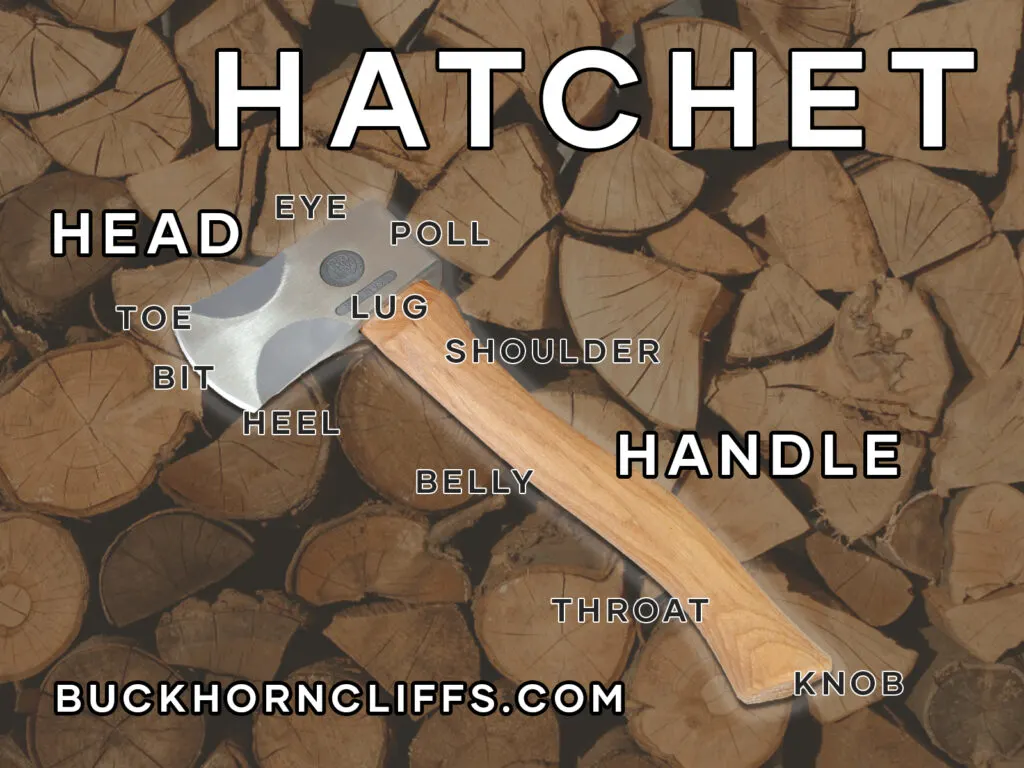
The anatomy/terminology of a hatchet is identical to that of an Axe.
Here are a few axe and hatchet recommendations. I own many axes and hatchets and these have made it to the top of the my list:
Axe Recommendations
Fiskars: The handle is considered stronger-than-steel, it’s a FiberComp handle with an inseparable insert-molded head. They’re virtually impossible to break. And yeah, I get it… it doesn’t look old-timey but I’ve used these a lot and everything about them is superior.
However, if you’re wanting an amazing, classic, wood handled axe, this 1844 Helko is pretty great.
Hatchet Recommendations
Similar to the axe recommend above, these Fiskars hatchets have an incredible blade, strong handle, and a solid weight distribution.
And for a compact camping hatchet, Gerber makes amazing products, highly recommended!
pin it
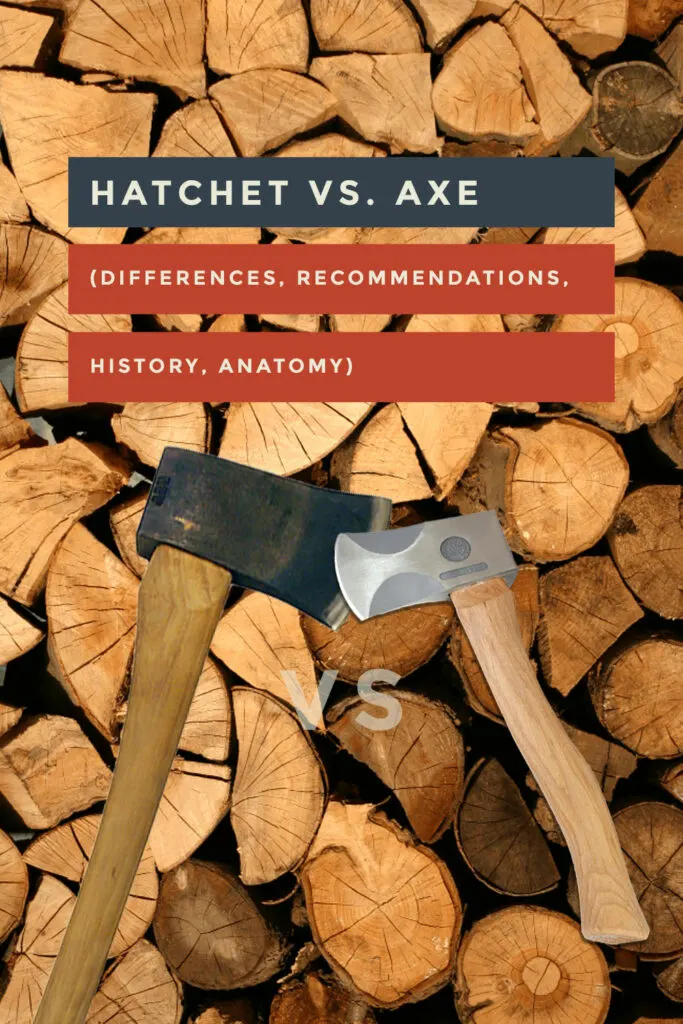
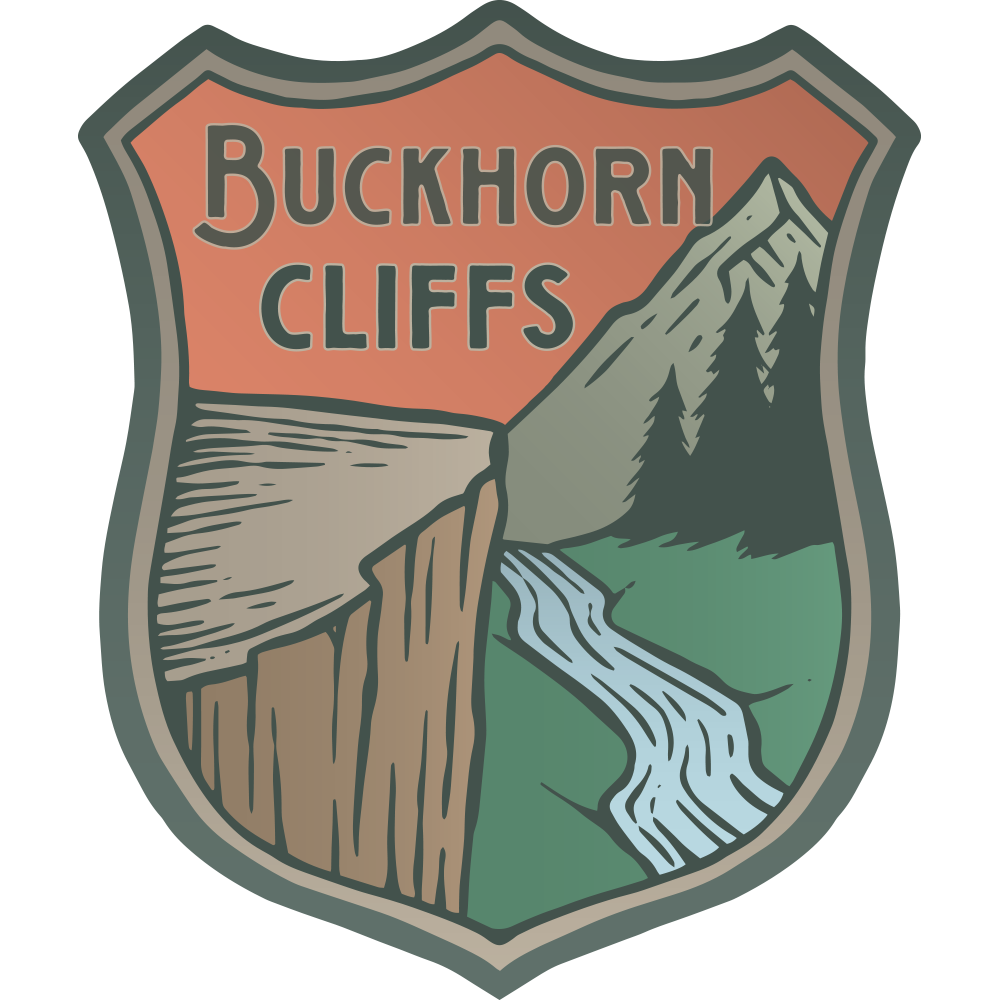
Joe
Monday 8th of July 2024
Just wanted to throw my 2 cents in there on the widespread misuse of "hatchet" for "hand ax." The difference has nothing to do with weight or handle length. I know, I know -- I'm outnumbered, but I am just siding with the manufacturers of the golden era of axes. A quick look at any of the major manufacturers' and retailers' catalogs quickly shows that Collins, Plumb, Mann, Vaughan, Sears, etc -- all of them, classified small, one-hand axes as *axes*, not hatchets. Hatchets were grouped together separately as construction tools with ax-like blades. But the terms in common use seem always to have been confused. And etymologically, they're the same word (ax, "ash-SHAY"), one Germanic, the other French. But me? I like to preserve the distinction the manufacturers themselves, unanimously, made. And it has nothing to do with weight nor handle length.
แทงสนุกเกอร์
Thursday 16th of March 2023
Pretty! This has been a really wonderful post. Many thanks for providing these details.
แทงสนุกเกอร์
Wednesday 15th of March 2023
Very well presented. Every quote was awesome and thanks for sharing the content. Keep sharing and keep motivating others.
สนุกเกอร์
Wednesday 15th of March 2023
I appreciate you sharing this blog post. Thanks Again. Cool.
สนุกเกอร์ออนไลน์
Tuesday 14th of March 2023
Awesome! Its genuinely remarkable post, I have got much clear idea regarding from this post